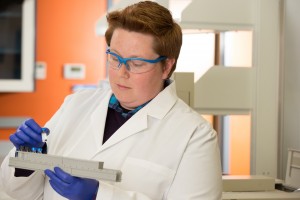
Many analytical methods used in polymer testing involve turning a solid sample into a liquid or gas prior to analysis. This allows scientists to better analyze the molecules that make up the polymer. Sometimes, however, those methods can be too time-consuming, difficult to accomplish without complications or contamination, or unable to detect the level of detail you need. Solid phase micro-extraction (SPME) is one solution to those challenges.
SPME is a sampling technique that uses a fiber coated with an extracting phase (usually a polymer, sometimes a solid sorbent) that extracts different kinds of analytes from various materials. SPME is a powerful analytical tool that reduces the number of steps involved in testing (and thereby the risk of error) while eliminating the need for a solvent to turn a sample into a liquid or gas. It can be used for liquid or volatiles sampling, but we usually use it for volatiles testing. It’s fast, it doesn’t usually use solvents, and you can get down to ppt levels for some compounds. It’s particularly helpful anywhere you need to achieve highly sensitive analysis of materials, such as in packaging.
You’ll often see SPME used in conjunction with gas chromatography (GC) and mass spectrometry (MS), two workhorses of chemical analysis. Typically, GC/MS testing for volatiles involves sampling through a heated gas-tight syringe, but if you need greater sensitivity and detail, conducting SPME prior to testing can help concentrate volatiles in the sample.
Volatiles are elements and compounds with low boiling points. Although many volatiles originate from liquids, some solid materials can actually transform directly from a solid into a vapor without ever transitioning to a liquid form. This process is called sublimation. If you’ve ever forgotten a tray of ice cubes in your freezer for a lengthy amount of time, you’ve likely witnessed sublimation first hand! Sublimation is what causes the ice cubes to shrink in the tray, as the water goes from a solid state (ice) directly to a gas without having to be melted.
Volatiles transforming easily into a vapor can be problematic in real-life applications — think of the volatile organic compounds that make paint stink. Volatiles are also why some plastics and rubber have a distinctive smell, and why tea is so fragrant. Volatiles are also responsible for new car smell, as the adhesives, sealers, and other additives used in the production of the car give off gas.
Often, our testing aims to detect trace levels of volatiles in a polymer sample. SPME is an effective, reliable way to supplement the accuracy and efficacy of GC/MS testing. One memorable project at PSI involved testing a puffed cheese snack to determine the source of a smell best described as spoiled milk. PSI scientists used SPME to sample the volatiles originating from the tub of the snack and then desorbed the SPME fiber into the injection port of a GC/MS. A scientist with a food science background identified hexenal and pentane as the cause of the foul odor. Both substances are markers of rancidity.
